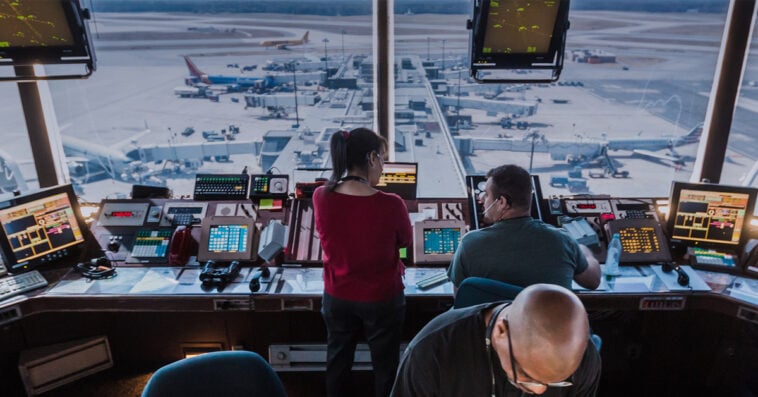Ever wondered what truly keeps America’s bustling skies safe and organized? You might picture cutting-edge technology, sleek monitors, and lightning-fast processors. The truth, until now, has been far more… retro. For years, the very systems guiding planes across the nation have quietly relied on technology that many of us last saw in a dusty attic: floppy disks and Windows 95. Yes, you read that right. But prepare for takeoff, because after decades of navigating with digital relics, a monumental upgrade is finally underway.
FAA Commits to Modernizing Outdated Air Traffic Systems
The Federal Aviation Administration (FAA) is officially charting a new course. Acting FAA Administrator Chris Rocheleau recently laid out a bold plan to overhaul the country’s air traffic control (ATC) system—a decades-old framework that has long lagged behind modern standards.
As reported by NPR, many of the nation’s ATC towers still operate with outdated tools, including physical paper strips for tracking flights, floppy disks for data transfers, and computers running Windows 95. These relics, surprisingly, may have shielded the FAA from the recent global CrowdStrike outage that crippled more modern systems—but officials agree that this is no excuse to delay modernization any further.
“The whole idea is to replace the system. No more floppy disks or paper strips,” Rocheleau told the House Appropriations Committee last June.
Transportation Secretary Sean Duffy echoed the urgency, calling it a rare point of national consensus: “This is the most important infrastructure project that we’ve had in this country for decades. Everyone agrees — this is non-partisan. Everyone knows we have to do it.”
The message is clear: America’s skies can’t rely on outdated tech forever. A new era of air traffic control is about to begin.
‘Modern Skies’ Campaign Rallies Industry Behind ATC Overhaul
That new era has a name: Modern Skies. Launched in May 2025, the Modern Skies campaign represents one of the most unified calls for infrastructure reform in aviation history. Backed by more than 50 industry groups—including airlines, pilot associations, manufacturers, and airport organizations—the coalition is urging swift action from Congress and the FAA to replace aging systems and bring U.S. air traffic control into the 21st century.
At the heart of the campaign is a demand for major investment. The FAA has already secured an initial $12.5 billion, but industry leaders argue that full modernization will require between $18 and $31 billion more over the next few years. And the numbers behind the transformation are just as ambitious: 4,600 new fiber-optic connections, 25,000 upgraded radios, 618 advanced radar systems, 200 new ground surveillance units, 15 air traffic control towers, and six state-of-the-art regional facilities are all part of the plan.
The push for change comes amid growing concern over the fragility of current infrastructure. Several incidents, including a fatal mid-air collision in January and recent radar outages at major airports like Newark, have exposed just how vulnerable the system has become. In some ways, the FAA’s outdated tech may have helped it sidestep the CrowdStrike outage that disrupted more modern networks worldwide, but experts warn this good luck is no substitute for long-term reliability.
To build public awareness and political pressure, the Modern Skies campaign launched a nationwide media effort, including a 30-second commercial showing 90s-era tech still in use at some air traffic centers. Alongside the tech upgrades, the campaign is also pressing for solutions to a worsening staffing crisis—one that’s left the FAA increasingly reliant on overtime and struggling to train new air traffic controllers fast enough to meet demand.
Why Upgrading ATC Isn’t So Simple
Unfortunately, replacing decades-old air traffic control systems isn’t as easy as swapping out a home computer. For one, many of these systems can’t ever be shut down—they operate 24/7 and are essential for flight safety. That means there’s no simple “off switch” that would allow for parts to be swapped or software overhauled. Upgrades must be done in real time, with the utmost care, and without disrupting operations.
Security is another critical concern. Because air traffic control is part of the nation’s critical infrastructure, any modernization effort must be resilient against cyber threats. One breach could do more than cause delays—it could paralyze the national airspace, costing money, time, and potentially lives. That level of risk leaves zero room for error.
Despite the system’s age, the FAA continues to pour funding into maintaining and patching its legacy equipment just to keep operations stable. But no amount of maintenance can hold off obsolescence forever. Even the most diligent repairs can’t outrun time.
At this stage, the FAA is already moving forward. It has issued a Request for Information (RFI) to identify companies capable of tackling this enormous challenge and has scheduled a series of “Industry Days” where vendors can pitch their ideas directly to the Department of Transportation.
Transportation Secretary Sean Duffy says the department hopes to complete the upgrade within four years. But many experts believe that the timeline is overly optimistic, given the complexity and scale of the project. Still, the clock is ticking, and after decades of underinvestment, the U.S. air traffic system can’t afford to wait any longer.
Source: FAA, NPR, Tom’s Hardware


